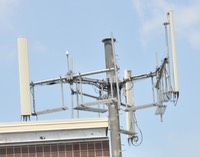The basic idea behind cooperative communications is to allow groups of radios to collaborate in the transmission of data. This can be thought of as creating a virtual antenna array, whereby each terminal donates its own antenna or antennas to form a large array comprised of many antennas. See the presentation given at Hughes Network Systems. We have developed a hybrid-ARQ-based approach to cooperative diversity [J8, J11], whereby the ARQ retransmissions could come from a relay rather than from the original transmitter. In [J12], we have investigated asynchronous cooperative diversity systems; i.e., systems that are tolerant of a relative delay among cooperative transmissions. In [B3], we give a tutorial introduction to distributed space-time codes. More recently, I have been considering cooperative cellular systems. In our 2013 Globecom paper [C82], we consider a Coordinated Multipoint (CoMP) system that combines the downlink transmissions from multiple base stations. This work builds on our earlier work [J40, C5] involving the combination of uplink transmissions across multiple base stations.
Matthew C. Valenti
Professor, Lane Department of Computer Science and Electrical Engineering
Copyright 2010-2022 Matthew C. Valenti
